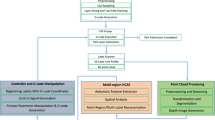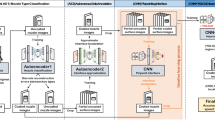Abstract
Metal additive manufacturing (AM) has become popular in a large variety of applications due to its excellent capabilities of handling complex geometries and novel materials. However, due to its process complexity, layer-wise surface quality issue is still one of the critical concerns to further broaden adoption of metal AM, because of the impact on products’ property and functionality. The existing experimental studies from literature have shown machine parameters could significantly affect the resulting surface morphology of printing products. Consequently, it is urgently necessary to analyze and model printing surface in metal AM, and thereby printing surface can be further correlated with machine parameters, enabling more appropriate quality assurance applications such as process design and post anomaly detection. However, there are two major practical challenges to realize this goal: (1) the printing surface profiles in metal AM are highly nonlinear; and (2) the measured surface profiles usually have significant outliers, shifts, and porosities. To address these two challenges, this paper models surface profile in a decomposition-based framework and develops a hybrid data-driven feature extraction approach, which integrates a robust convolutional autoencoder-based approach and conventional statistics-based approach. Through the incorporation of supervised machine learning algorithm, the underlying relationship between machine parameters and printing surface can be thereby clearly quantified. To validate effectiveness of the proposed method, both simulation and a real-world case study in laser-engineered net shaping (LENS) were conducted in this work. The results demonstrate that the classification accuracy using the proposed method could achieve 86% in simulation cases and 74% in an actual LENS experiment, which outperforms the benchmark methods with better robustness. Therefore, it demonstrates that the developed approach is very promising for surface morphology analysis and process optimization of metal AM.
















Similar content being viewed by others
Code availability
The Python codes for conducting this work are available upon reasonable request.
References
Zhang Y, Sahasrabudhe H, Bandyopadhyay A (2015) Additive manufacturing of Ti-Si-N ceramic coatings on titanium. Appl Surf Sci 346:428–437
Ahmed N (2019) Direct metal fabrication in rapid prototyping: a review. J Manuf Process 42:167–191
Frazier WE (2014) Metal additive manufacturing: a review. J Mater Eng Perform 23(6):1917–1928
Bandyopadhyay A et al (2009) Application of laser engineered net shaping (LENS) to manufacture porous and functionally graded structures for load bearing implants. J Mater Sci - Mater Med 20(1):29
Li Y et al (2017) Additive manufacturing of alumina using laser engineered net shaping: Effects of deposition variables. Ceram Int 43(10):7768–7775
Culmone C, Smit G, Breedveld P (2019) Additive manufacturing of medical instruments: A state-of-the-art review. Addit Manuf 27:461–473
Ngo TD et al (2018) Additive manufacturing (3D printing): a review of materials, methods, applications and challenges. Compos B Eng 143:172–196
Liu Z et al (2019) Influence of energy density on macro/micro structures and mechanical properties of as-deposited Inconel 718 parts fabricated by laser engineered net shaping. J Manuf Process 42:96–105
Razavi SMJ et al (2021) Porosity effect on tensile behavior of Ti-6Al-4V specimens produced by laser engineered net shaping technology. Proc Inst Mech Eng C J Mech Eng Sci 235(10):1930–1937
Liu S et al (2019) Multiphysics modeling of phase transformation and microhardness evolution in laser direct deposited Ti6Al4V. J Manuf Process 45:579–587
Khanzadeh M et al (2018) Porosity prediction: supervised-learning of thermal history for direct laser deposition. J Manuf Syst 47:69–82
Zhou C, Paffenroth RC (2017) Anomaly detection with robust deep autoencoders. In Proceedings of the 23rd ACM SIGKDD International Conference on Knowledge Discovery and Data Mining
Fox JC et al (2016) Preliminary study toward surface texture as a process signature in laser powder bed fusion additive manufacturing. In 2016 Summer Topical Meeting: Dimensional Accuracy and Surface Finish in Additive Manufacturing
Shu D et al (2020) 3d design using generative adversarial networks and physics-based validation. J Mech Des 142(7):071701
Shi Z et al (2022) An LSTM-autoencoder based online side channel monitoring approach for cyber-physical attack detection in additive manufacturing. J Intell Manuf 1–17
Chalapathy R, Menon AK, Chawla S (2017) Robust, deep and inductive anomaly detection. in Joint European conference on machine learning and knowledge discovery in databases. Springer
Kummailil J et al (2005) Effect of select LENS™ processing parameters on the deposition of Ti-6Al-4V. J Manuf Process 7(1):42–50
Oliveira JP, LaLonde A, Ma J (2020) Processing parameters in laser powder bed fusion metal additive manufacturing. Mater Des 193:108762
Jiang H-Z et al (2019) Factor analysis of selective laser melting process parameters with normalised quantities and Taguchi method. Opt Laser Technol 119:105592
Liu Z et al (2019) Effects of deposition variables on molten pool temperature during laser engineered net shaping of Inconel 718 superalloy. Int J Adv Manuf Technol 102(1):969–976
Shi Z et al (2021) Surface morphology analysis using convolutional autoencoder in additive manufacturing with laser engineered net shaping. Procedia Manuf 53:16–23
Zhang M et al (2017) Fatigue and fracture behaviour of laser powder bed fusion stainless steel 316L: influence of processing parameters. Mater Sci Eng A 703:251–261
Ansari M et al (2019) Laser directed energy deposition of water-atomized iron powder: Process optimization and microstructure of single-tracks. Opt Laser Technol 112:485–493
Ding D et al (2015) Wire-feed additive manufacturing of metal components: technologies, developments and future interests. Int J Adv Manuf Technol 81(1):465–481
Senthilkumar N, Tamizharasan T, Anandakrishnan V (2014) Experimental investigation and performance analysis of cemented carbide inserts of different geometries using Taguchi based grey relational analysis. Measurement 58:520–536
Khalid M, Peng Q (2021) Investigation of printing parameters of additive manufacturing process for sustainability using Design of Experiments. J Mech Des 143(3):032001
Zhai Y et al (2019) Understanding the microstructure and mechanical properties of Ti-6Al-4V and Inconel 718 alloys manufactured by laser engineered net shaping. Addit Manuf 27:334–344
Ferguson J et al (2015) Semi-empirical model of deposit size and porosity in 420 stainless steel and 4140 steel using laser engineered net shaping. J Manuf Process 19:163–170
Kustas AB et al (2018) Characterization of the Fe-Co-1.5 V soft ferromagnetic alloy processed by Laser Engineered Net Shaping (LENS). Addit Manuf 21:41–52
Patalas-Maliszewska J et al (2020) Single tracks as a key factor in additive manufacturing technology—analysis of research trends and metal deposition behavior. Materials 13(5):1115
Stašić J, Božić D (2016) The effect of NiB additive on surface morphology and microstructure of 316L stainless steel single tracks and layers obtained by SLM. Surf Coat Technol 307:407–417
Yueling G et al (2018) Single track and single layer formation in selective laser melting of niobium solid solution alloy. Chin J Aeronaut 31(4):860–866
Hocken RJ, Pereira PH (2016) Coordinate measuring machines and systems. CRC press
Lang C, Boning D (2017) Spin coating modeling and planarization using fill patterns for advanced packaging technologies. In 2017 28th Annual SEMI Advanced Semiconductor Manufacturing Conference (ASMC). IEEE
Cabanettes F et al (2018) Topography of as built surfaces generated in metal additive manufacturing: a multi scale analysis from form to roughness. Precis Eng 52:249–265
Lin W et al (2019) Online quality monitoring in material extrusion additive manufacturing processes based on laser scanning technology. Precis Eng 60:76–84
Ye Z et al (2020) A deep learning approach for the identification of small process shifts in additive manufacturing using 3D point clouds. Procedia Manuf 48:770–775
Yao B et al (2018) Multifractal analysis of image profiles for the characterization and detection of defects in additive manufacturing. J Manuf Sci Eng 140(3)
Ding R et al (2015) Electron microscopy study of direct laser deposited IN718. Mater Charact 106:324–337
Kim J, Heo G, Lagravère MO (2014) Accuracy of laser-scanned models compared to plaster models and cone-beam computed tomography. Angle Orthod 84(3):443–450
Wang X et al (2017) Morphology analysis and process research on novel metal fused-coating additive manufacturing. In IOP Conference Series: Materials Science and Engineering. IOP Publishing
Fox JC, Moylan SP, Lane BM (2016) Effect of process parameters on the surface roughness of overhanging structures in laser powder bed fusion additive manufacturing. Procedia Cirp 45:131–134
Townsend A et al (2016) Surface texture metrology for metal additive manufacturing: a review. Precis Eng 46:34–47
Thompson A et al (2018) Internal surface measurement of metal powder bed fusion parts 20:126–133
Tootooni MS et al (2016) Online non-contact surface finish measurement in machining using graph theory-based image analysis. J Manuf Syst 41:266–276
Jiang X, Scott P, Whitehouse D (2008) Wavelets and their applications for surface metrology. CIRP Ann 57(1):555–558
Wang X et al (2017) Using wavelet packet transform for surface roughness evaluation and texture extraction. Sensors 17(4):933
Tsai D-M, Chen J-J, Chen J-F (1998) A vision system for surface roughness assessment using neural networks. Int J Adv Manuf Technol 14(6):412–422
Liu C et al (2022) Toward online layer-wise surface morphology measurement in additive manufacturing using a deep learning-based approach. J Intell Manuf 1–17
Hertlein N et al (2021) Generative adversarial network for early-stage design flexibility in topology optimization for additive manufacturing. J Manuf Syst 59:675–685
Khanzadeh M et al (2016) Porosity detection of laser based additive manufacturing using melt pool morphology clustering. Ann Int Solid Freeform Fabr Symp (SFF)
Chen M et al (2017) Deep feature learning for medical image analysis with convolutional autoencoder neural network. IEEE Transactions on Big Data 7(4):750–758
Sun Y, Wang X, Tang X (2014) Deep learning face representation from predicting 10,000 classes. Proc IEEE Conf Comput Vis Pattern Recognit
Boyd S, Boyd SP, Vandenberghe L (2004) Convex optimization. Cambridge University Press
Boyd S, Parikh N, Chu E (2011) Distributed optimization and statistical learning via the alternating direction method of multipliers. Now Publishers Inc
Mosci S et al (2010) Solving structured sparsity regularization with proximal methods. in Joint European conference on machine learning and knowledge discovery in databases. Springer
Lou S et al (2019) Characterisation methods for powder bed fusion processed surface topography. Precis Eng 57:1–15
Townsend A et al (2016) Surface texture metrology for metal additive manufacturing: a review 46:34–47
Breiman L (2001) Random forests. Mach Learn 45(1):5–32
Rodriguez-Galiano VF et al (2012) An assessment of the effectiveness of a random forest classifier for land-cover classification. ISPRS J Photogramm Remote Sens 67:93–104
Breiman L (1996) Bagging predictors. Mach Learn 24(2):123–140
Abadi M et al (2016) Tensorflow: large-scale machine learning on heterogeneous distributed systems. arXiv preprint arXiv:1603.04467
Noble WS (2006) What is a support vector machine? Nat Biotechnol 24(12):1565–1567
Margineantu DD, Dietterich TG (1997) Pruning adaptive boosting. in ICML. Citeseer
Friedman JH (2002) Stochastic gradient boosting. Comput Stat Data Anal 38(4):367–378
Powers DM (2011) Evaluation: from precision, recall and F-measure to ROC, informedness, markedness and correlation
Chacón J et al (2017) Additive manufacturing of PLA structures using fused deposition modelling: Effect of process parameters on mechanical properties and their optimal selection. Mater Des 124:143–157
Yu J-H et al (2018) Repairing casting part using laser assisted additive metal-layer deposition and its mechanical properties. Opt Laser Technol 106:87–93
Gong H et al (2014) Analysis of defect generation in Ti–6Al–4V parts made using powder bed fusion additive manufacturing processes. Addit Manuf 1:87–98
Author information
Authors and Affiliations
Corresponding author
Ethics declarations
Ethical approval
Not applicable.
Consent to participate
Not applicable.
Consent for publication
Not applicable.
Conflict of interest
The authors declare no competing interests.
Additional information
Publisher's Note
Springer Nature remains neutral with regard to jurisdictional claims in published maps and institutional affiliations.
Rights and permissions
About this article
Cite this article
Shi, Z., Mandal, S., Harimkar, S. et al. Hybrid data-driven feature extraction-enabled surface modeling for metal additive manufacturing. Int J Adv Manuf Technol 121, 4643–4662 (2022). https://doi.org/10.1007/s00170-022-09608-z
Received:
Accepted:
Published:
Issue Date:
DOI: https://doi.org/10.1007/s00170-022-09608-z




